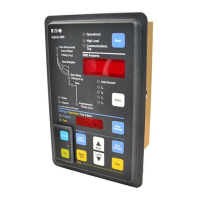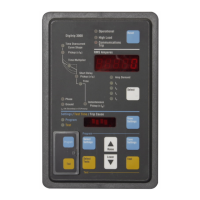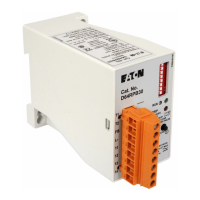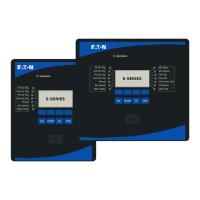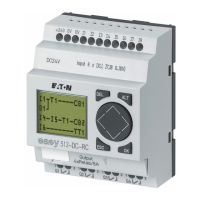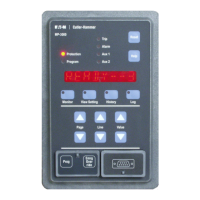I.B. 17555C
Effective November 1999
Page 19
SECTION 3: OPERATION
3-1 INTRODUCTION
This section specifically describes the operation and
functional use of the Digitrip 3000 Protective Relay. It
does not address in detail rear power connections and
DIP switch settings. These topics are covered in SEC-
TION 5 entitled “INSTALLATION, STARTUP AND TEST-
ING.” It would be helpful, however, to become familiar
with the relay’s wiring diagram before proceeding with the
rest of this section (Figure 3-1).
3-2 POWER-UP AND SELF TESTING
When the proper AC or DC control voltage is applied to
power supply input terminals, the unit will initiate a
“Power On Reset” to its chip circuitry. This causes the
unit’s firmware to perform some self-testing and initializa-
tion of its ROM, RAM and E
2
(non-volatile) memory. If any
problem exists, a diagnostic message will be displayed in
the Settings/Test Time/Trip Cause Window. A complete
list of messages and their meanings are given in Table
3.2. Additionally, if a problem does exist, the “Operational
LED” will light red and the “Protection Off Alarm” relay will
not energize. When all self checks are good, the “Protec-
tion Off Alarm” relay will energize, and the “Operational
LED” will blink green.
3-3 PANEL OPERATIONS
Begin by reviewing the material presented in SECTION 2
entitled “FUNCTIONAL DESCRIPTION.” Since basic def-
initions and explanations were given in SECTION 2, no
further explanation as to function will be offered in this
section. It is assumed that the operator is now familiar
with Digitrip 3000 terms, available settings and overall
capabilities.
3-3.1 CHARACTERISTIC CURVE
Digitrip 3000 Protective Relays provide circuit breakers
with an extensive degree of selective coordination poten-
tial and permit curve shaping over a wide range. Avail-
able pickup settings, inverse time overcurrent time
multiplier settings and inverse time overcurrent (phase
and ground) curve selections are addressed here with
respect to their effect on the resultant characteristic
curve. In general, there are three different families of
curves to choose from as shown in Table 3.1. These
curves were discussed briefly in Sections 1 and 2. The
operating characteristics of the relay are graphically rep-
resented by time-current characteristic curves shown in
Figure 3-2.
As shown in Figure 3-1, the ANSI and IEC “Curve
Shapes” are in terms of multiples of (Pickup Current
of the CT Primary), whereas ‘short delay” and
“instantaneous” are in terms of multiples of In (5A
secondary of CT primary current). The thermal curve
is represented in terms of multiples of In for its curve
shape, short delay, and instantaneous settings. This
must be considered in the Coordination study and in
the programming of the Digitrip 3000 Protective
Relay.
The ANSI curves are defined by ANSI C37.l 12 and IEC
curves are defined by lEC 255-3. These curve shapes
combine with the customized capability of the short delay
and instantaneous functions to allow for very versatile
coordinated protection schemes. The thermal curve
shape is also customized by the user to any desired type
of coordinated protection scheme.
These curves show how and when a particular relay will
act for given values of time and current. The more versa-
tile the relay, the easier it is to accomplish close coordina-
tion and achieve optimum protection. Since the Digitrip
3000 Protective Relay is very versatile, the makeup of a
typical curve is presented for clarification purposes.
For the sake of simplification, the curve discussion will
center around a single line curve. Keep in mind, however,
that a characteristic curve in reality is represented by a
band of minimum and maximum values, not a line (Figure
3-2). Minimum and maximum values are generally the
result of tolerances introduced by the manufacturing pro-
cess for components and the relay’s accuracy. Any
expected value of tripping current or time could be the
nominal value anticipated within the plus or minus toler-
ance. The tolerances just mentioned are usually stated in
terms of the relay’s accuracy and frequently highlighted
on the actual working curves. Accuracy is stated in terms
of a plus or minus percentage and represents a permitted
fluctuation on either side of the nominal tripping point for
a family of relays, like the Digitrip 3000.
TABLE 3.1 DIGITRIP 3000 CURVE SHAPES
Thermal
Curves
ANSI Curves
(per ANSI C37.112)
IEC Curves
(per IEC 255-3)
It Moderately Inverse IEC-A
I
2
t
Very Inverse IEC-B
I
4
t
Extremely Inverse IEC-C
FLAT IEC-D

